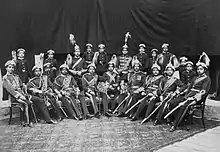Rolls of Succession in Rana (Nepal)
Rolls of Succession in Rana was the order of succession, sequence of members of the Rana Royal Family of Nepal in the order in which they stand in line to office of Prime Minister of Nepal and Shree Teen Maharaja of Kaski and Lamjung along with the top ten high military ranks.[1] This sequence was regulated not only through descent, but also by purity of lineage.[2]Jung Bahadur Rana established the official Rolls of Succession that ranked all his descendants in relation to their hereditary rights to the office of prime minister as it would be passed down in the family for generations, with no legal mechanism for changing the government.

Jung Bahadur Rana
After King Surendra issued a royal decree (sanad) that formalized the dominance of the Kunwar family along with giving Jung Bahadur the complete authority over all internal administration, including civil, military, and judicial affairs, and all foreign relations, including the powers to make war and peace.Jung Bahadur was made great king (maharajah) of Kaski and Lamjung districts, in effect serving as their independent ruler and the right to use the honorific term shri three times (Sri Teen) with his name.In his sanad of 1856 King Surendra stated that the line of succession would go to Junga's seven brothers and then to Junga's sons and nephew in order of seniority.[3]After King's royal decree Jung Bahadur Rana established official Rolls of Succession that ranked all his descendants in relation to their hereditary rights to the office of prime minister.These provisions meant that the dictatorship of the Kunwar family, a virtual monarchy within the monarchy, would be passed down in the family for generations, with no legal mechanism for changing the government.
Chandra Shumsher's Revision
In Prime Minister Chandra Shumsher JBR revised and re-suffeled the Rolls of Succession in Rana family and divided the Rana clan of Nepal into 3 categories of A,B,C according to the stature of the purity of lineage.[4]
- A Class were those born of legitimate high caste married wives.[5]
- B Class were those born of legitimate married wives of secondary high caste or those born from marriage with the royal household member.
- C Class were those born of illegitimate wives of lower cast .
A Class could fit for position of Prime Minister and Highest Military and administrative Officials where as B and C Class Rana could only reach the level of Colonel.
Juddha Shumsher's Revision
In March 1934 Juddha Shumsher JBR expled the C Class Rana from the direct roll of succession.[6]
See also
- Daudaha system
- Pajani System
- Rana palaces of Nepal
- Rana Administration
References
- Indra Adhikari (12 June 2015). Military and Democracy in Nepal. Taylor & Francis. pp. 116–. ISBN 978-1-317-58905-1.
- JBR, PurushottamShamsher (1990). Shree Teen Haruko Tathya Britanta (in Nepali). Bhotahity, Kathmandu: Vidarthi Pustak Bhandar. ISBN 99933-39-91-1.
- Bhuwan Lal Joshi; Leo E. Rose (1966). Democratic Innovations in Nepal: A Case Study of Political Acculturation. University of California Press. pp. 34–. GGKEY:5N30S3HU9BC.
- Ramjee P. Parajulee (January 2000). The Democratic Transition in Nepal. Rowman & Littlefield. pp. 35–. ISBN 978-0-8476-9577-5.
- IBP USA (3 March 2012). Nepal Country Study Guide - Strategic Information and Developments. Lulu.com. pp. 57–. ISBN 978-1-4387-7514-2.
- Ishwari Prasad (1 January 1996). The Life and Times of Maharaja Juddha Shumsher Jung Bahadur Rana of Nepal. APH Publishing. pp. 162–. ISBN 978-81-7024-756-2.